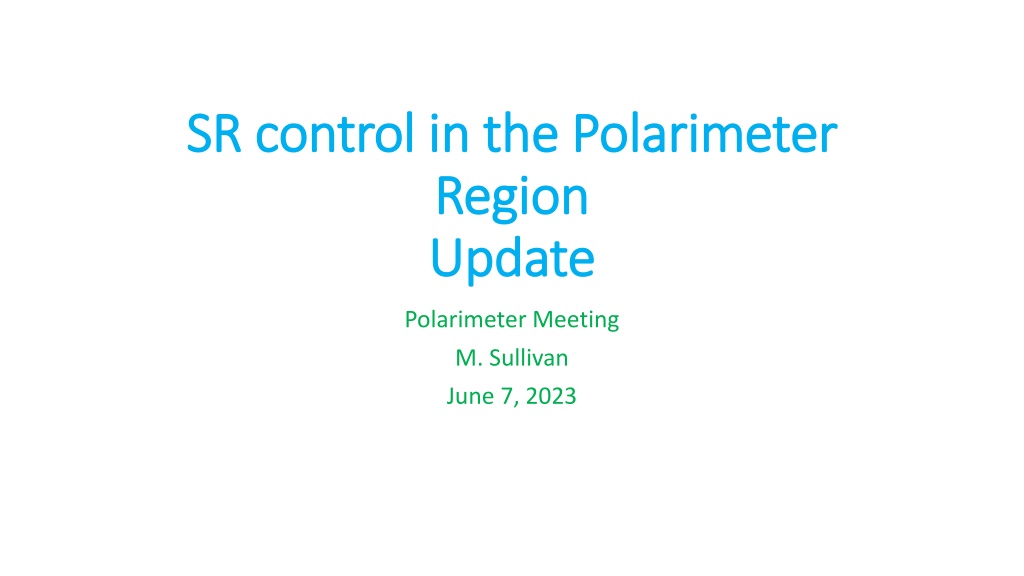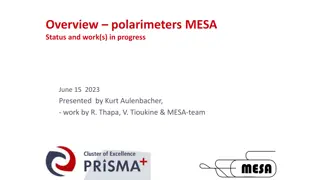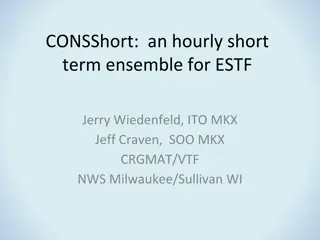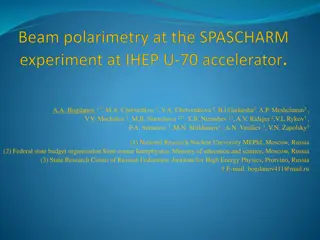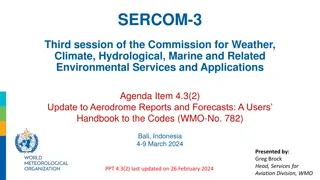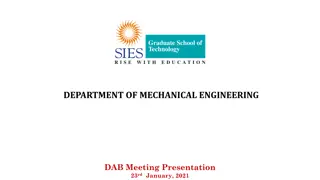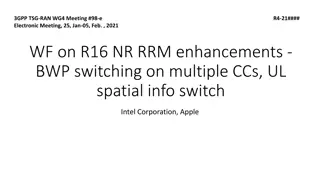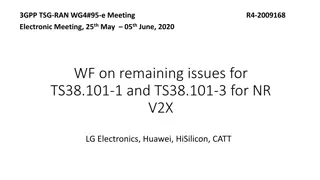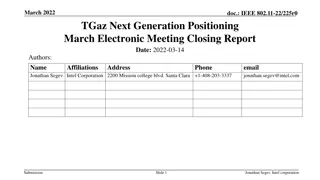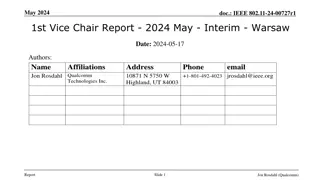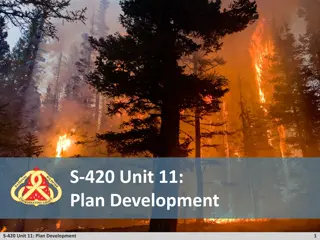Update on Polarimeter Meeting with M. Sullivan
Presenting a recap of issues regarding the 18 GeV and 10 GeV polarimeter regions, including details on photon windows, power densities, mask suggestions for absorbing radiation, and engineering considerations. The content also discusses the SR power from bend magnets and water cooling requirements for the B2 and B3 systems.
Download Presentation

Please find below an Image/Link to download the presentation.
The content on the website is provided AS IS for your information and personal use only. It may not be sold, licensed, or shared on other websites without obtaining consent from the author. Download presentation by click this link. If you encounter any issues during the download, it is possible that the publisher has removed the file from their server.
E N D
Presentation Transcript
SR control in the Polarimeter SR control in the Polarimeter Region Region Update Update Polarimeter Meeting M. Sullivan June 7, 2023
Outline Recap of the issues 18 GeV Various W thicknesses 10 GeV W thickness Summary
Drawing of polarimeter region Each 1/8 fan slice has: 4090 W for B3 and 3566 W for B2 Some notes: 1. Power density at a photon window near the electron detector is 22.4 kW over 5 cm = 450 W/mm 2. Will melt all materials 3. Long vacuum tube to move the window away from the sources 4. With a mask positioned as shown the photon window sees mostly quadrupole radiation Total SR power from these 2 bend magnets is 32.86 kW Water cooling B2 B3
Photon window for the polarimeter Previous presentations had these power numbers on the window 10 W/mm2 is about the usual engineering maximum W fan ht (mm) W/mm2 Kc (keV) E/bun (keV) # /bun # >20 keV From B3 2752 4.5 12.2 67 1.7e12 8.3e10 2.3e10 From B2 7703 2.8 55.0 63 4.8e12 2.5e11 6.7e10 18 GeV W fan ht (mm) W/mm2 Kc (keV) E/bun (keV) # /bun # >20 keV From B3 2366 4.5 10.5 12 6.9e7 1.9e7 8.2e5 From B2 6158 2.8 44.0 11 4.8e12 2.5e11 6.7e10 10 GeV
Photon window (2) The fan height from the far magnet (D3) is 4.5 mm (round up to 5 mm) The fan height from the near magnet (D2) is 2.8 mm (round up to 3 mm) Suggest we put a horizontal mask into the photon beam pipe down near the window that is high enough to absorb the bend fan radiation about halfway between the laser IP and the photon window Needs to be at least 8mm high in order to get water cooling into the mask ( 4 mm in Y) At the suggested location (44 m 2 m upstream of the window), the mask would occlude a horizontal slice of the photon window approx. 5 mm by 5 cm Can be sloped so that the power density is manageable Cartoon (next slide) has a sloped surface that is 5 cm by 150 cm (could be more)
Drawing of polarimeter region Each 1/8 fan slice has: 4090 W for B3 and 3566 W for B2 Some details: 1. Hole in beam pipe for the photons is a long oval about 1.6 m in X by 6 cm in Y 2. Propose adding a smaller horizontal slit (3.7 m in X and 1.5 cm in Y) to the above to let the first 3 slices of the B2 fan hit the mask 3. Engineering needed for the crotch area 4. Photon window sees mostly quad radiation Total SR power from these 2 bend magnets is 32.86 kW Water cooling B2 B3
Some numbers Studied the power density as a function of the mask size If the mask is +/- 4 mm (8 mm in Y) and 55 mm in X (from the beam pipe wall to 5 mm past the center of the beam pipe) then The photon window receives almost only quadrupole radiation The total power on the window is now 116 W This is 3.96 109 photons per beam bunch incident on the window >1 keV The mask at this location (2 m upstream of the photon window) intercepts 6152 W If we slope the mask over 1.5 m, then the linear power density is 4.1 W/mm which should be OK There is a lot of SR power spraying down this beam pipe so we will need to water cool this entire pipe
Photons incident on the photon window The program SYNC_BKG gives me the number of photons incident on the photon window as well as an estimate of the energy spectrum I can use this information as input to my 2nd program MASKING to get an estimate of the number of incident photons that get through the window
Photons incident on and through the window I simulated a 2 mm Al window with 100 million incident photons with perpendicular incidence I found that 1848153 (1.8%) go through with most of the soft photons being absorbed Normalizing this number, we get 39.6 x 1848153 = 7.32 107 photons getting through per beam bunch I also simulated a window with 2 mm Al then 2 mm H2O and then 2 mm Pb I found that 6676 (6.7 10 5) got through which (normalized) equals 2.64 105 photons per bunch and this is equal to 23.8 GeV per beam bunch Also did the same as previous but with 2 mm of W instead of Pb I found that 461 (4.6 10 6) got through which (normalized) equals 1.83 104 photons per bunch and this is equal to 2.48 GeV per beam bunch
Discussion and next runs I noticed that the photon energy spectrum is cut off in the Pb and W plots (in the backup slides) I didn t generate photons out to a high enough energy (my default is 150 keV) Even though there are very few photons above 150 keV most of them get through The default is easy to change So I ran with an energy range of 1-300 keV Also some runs from 1-500 keV Also checked 10 GeV beam 1.06x109 photons > 1keV incident on the photon window Also get 99.9 W of quadrupole power on the window
Numbers for 1-300 and 1-500 keV runs (18 GeV) We still have 3.96 109 photons per beam bunch incident on the window >1 keV For 2 mm Al, 2 mm H2O and 2 mm W with range 1-300 keV we get: 29739 photons out of 100M incident getting through We normalize this by multiplying by 39.6 to get 1.178x106 photons per beam bunch This corresponds to 258 GeV/bunch For 2 mm Al, 2 mm H2O and 5 mm W with range of 1-500 keV we get: 3.85x105 photons/bunch and 117 GeV/bunch
Some plots 2 mm W incident energy range 1-300 keV 5 mm W incident energy range 1-300 keV
1-500 keV incident energy range Incident energy distribution on photon window Energy plot of photons that go through 5 mm W
W was then increased to 1 cm then to 2 cm For 2 mm Al, 2 mm H2O and 1 cm W with a range of 1-500 KeV 6.52x104 photons getting through/bunch Energy getting through is 22.9 GeV/beam bunch For 2 mm Al, 2 mm H2O and 2 cm W with a range 1-500 keV 3600 photons getting through with a total of 1.39 GeV energy/ bunch These numbers are starting to seem acceptable
Beam tails I thought that these high energy photons which are getting through even 2 cm of W were coming from the beam tail distribution and the beam particle density out at these high beam sigmas is not well known I tried a more favorable beam tail distribution (fewer particles out at high sigmas) and discovered that I got very little difference Closer inspection of my output file from SYNC_BKG revealed that some of the bend radiation is still getting around the proposed mask The output information indicates which sources are contributing to a particular surface
10 GeV As expected, the 10 GeV SR energy spectrum is much softer We now have 1.06 109 photons per beam bunch incident on the window >1 keV (4 times less than 18 GeV) For 2 mm Al, 2 mm H2O and 2 mm W with range 1-150 keV we get: 4 photons out of 1B incident getting through We normalize this by multiplying by 1.06 to get 4 photons per beam bunch This corresponds to 269 keV/bunch 2 mm of W is more than adequate to shield the photon detector from the SR
Summary The SR on the photon window can be managed if we can insert a mask a couple of meters upstream of the window that is designed to absorb almost all of the bend radiation We are then left with mostly quadrupole radiation and some leftover bend radiation which comes to about 120 W Fairly broad peak at the center of the window We may need a fairly thick W shield ( 2 cm) for the 18 GeV beam The 10 GeV beam has a softer photon energy spectrum and we have found that 2 mm of W looks to be quite effective in blocking all of the SR photons at this beam energy
Next steps Zhengquiao has asked if the quadrupole just upstream of the electron detector might not have SR that hits the electron detector I have come up with a plan to put that quad in my model but have not yet done so. Hope to do that soon. With the quad so close to the electron detector I do not think that it is capable of putting much background into the detector but it does need to be checked His excellent point is that the detector is quite close to the beam envelope
Incident energy spectrum Quadrupole radiation incident on the polarimeter photon window Meant to show these plots last time
Through photons Energy spectrum of photons that go through 2 mm of Al
Through photons Energy spectrum of photons that go through: 2mm of Al + 2 mm H2O + 2 mm Pb Note the K shell peak at 82 keV
Through photons Energy spectrum of photons that go through: 2mm of Al + 2 mm H2O + 2 mm W Most are at the high end
18 GeV plots with 1 cm and 2 cm of W 2 mm Al, 2 mm H2O and 1 cm W 2 mm Al, 2 mm H2O and 2 cm W
10 GeV SR plots Note: The range is out to only 150 keV This is a much softer energy distribution as expected Incident photon energy distribution (1 billion events)
